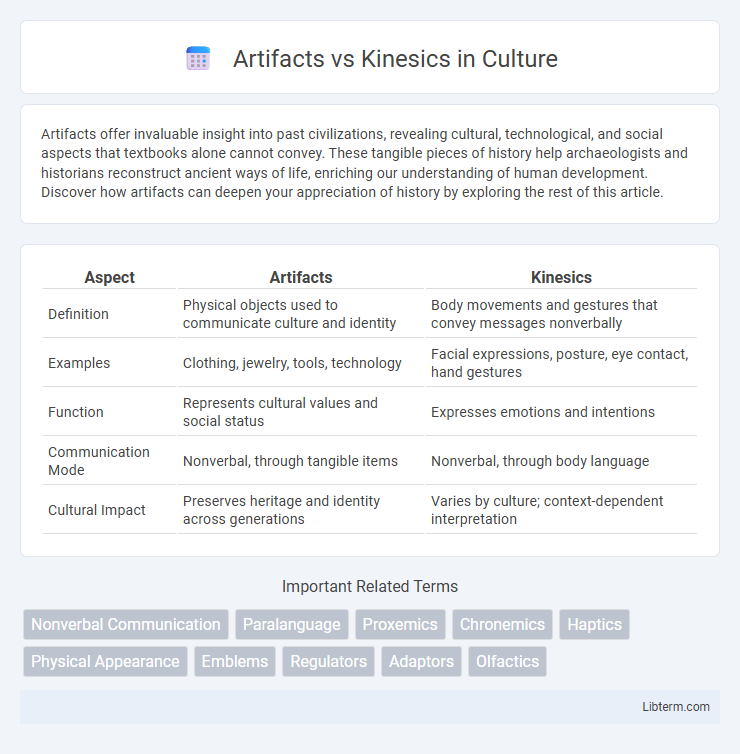Artifacts offer invaluable insight into past civilizations, revealing cultural, technological, and social aspects that textbooks alone cannot convey. These tangible pieces of history help archaeologists and historians reconstruct ancient ways of life, enriching our understanding of human development. Discover how artifacts can deepen your appreciation of history by exploring the rest of this article.
Table of Comparison
| Aspect | Artifacts | Kinesics |
|---|---|---|
| Definition | Physical objects used to communicate culture and identity | Body movements and gestures that convey messages nonverbally |
| Examples | Clothing, jewelry, tools, technology | Facial expressions, posture, eye contact, hand gestures |
| Function | Represents cultural values and social status | Expresses emotions and intentions |
| Communication Mode | Nonverbal, through tangible items | Nonverbal, through body language |
| Cultural Impact | Preserves heritage and identity across generations | Varies by culture; context-dependent interpretation |
Understanding Artifacts and Kinesics
Artifacts refer to physical objects or elements within an environment that convey nonverbal communication, such as clothing, jewelry, or personal belongings, which reflect cultural identity and social status. Kinesics involves the study of body movements, gestures, facial expressions, and posture as forms of nonverbal communication that express emotions, intentions, and social signals. Understanding artifacts and kinesics enhances interpretation of contextual cues and improves communication effectiveness across diverse social and cultural interactions.
Defining Artifacts in Communication
Artifacts refer to the physical objects and visual elements individuals use to convey messages and express identity in communication, such as clothing, jewelry, and personal belongings. These tangible items function as nonverbal cues that influence perceptions and social interactions by signaling status, cultural affiliation, and personality traits. Unlike kinesics, which involves body movements and gestures, artifacts communicate through the symbolic meaning embedded in objects within a social context.
Exploring Kinesics: The Language of Body Movement
Kinesics, the language of body movement, encompasses gestures, facial expressions, posture, and eye contact to convey nonverbal messages crucial for communication. Unlike artifacts, which involve objects and physical items signifying social status or identity, kinesics directly reflects emotional states and intentions through dynamic bodily behaviors. Studying kinesics provides insight into how subtle variations in movement influence interpersonal interactions and cultural understanding.
Key Differences Between Artifacts and Kinesics
Artifacts refer to physical objects and personal belongings that convey nonverbal messages, such as clothing, jewelry, or accessories, revealing cultural identity and social status. Kinesics involves body movements, including gestures, facial expressions, posture, and eye contact, to communicate emotions and intentions without words. The key difference lies in artifacts being tangible items used as communication tools, while kinesics encompasses dynamic, nonverbal bodily behaviors expressing interpersonal messages.
Cultural Significance of Artifacts
Artifacts hold deep cultural significance as tangible objects that embody historical heritage, social values, and collective identity within a community. They serve as physical representations of traditions, customs, and beliefs passed down through generations, often used in rituals or as symbols of status. Unlike kinesics, which concerns body language and nonverbal communication, artifacts provide a lasting cultural narrative that informs anthropological and sociological understanding.
The Role of Kinesics in Nonverbal Communication
Kinesics plays a pivotal role in nonverbal communication by conveying emotions and intentions through body movements, gestures, facial expressions, and posture, which often reveal underlying feelings more accurately than spoken words. Unlike artifacts, which involve physical objects used to communicate status or identity, kinesics directly influences interpersonal interactions by providing immediate and dynamic cues that shape understanding and responses in social contexts. Research in communication studies highlights that effective interpretation of kinesic signals enhances empathy, trust, and clarity, making it an essential component of human communication.
Impact of Artifacts on First Impressions
Artifacts, such as clothing, jewelry, and personal belongings, significantly influence first impressions by conveying status, personality, and cultural background before any verbal communication occurs. These visual cues shape perceptions of professionalism, trustworthiness, and social identity, often impacting interpersonal interactions more immediately than kinesics, or body language. The strategic use of artifacts can enhance or undermine initial judgments, playing a critical role in social, professional, and cross-cultural settings.
Interpreting Kinesics Across Cultures
Interpreting kinesics across cultures requires understanding that body language, facial expressions, and gestures can hold vastly different meanings depending on cultural context. While artifacts like clothing or objects often convey specific cultural identities, kinesics involves nonverbal cues such as eye contact, posture, and hand movements that may signal respect, aggression, or submission differently worldwide. Misreading these nonverbal signals can lead to communication breakdowns, highlighting the need for cultural awareness in interpreting kinesics effectively.
Practical Applications: Artifacts vs Kinesics in Daily Life
Artifacts such as clothing, jewelry, and accessories communicate social status, cultural identity, and personal preferences in daily interactions, influencing first impressions and social dynamics. Kinesics, encompassing body language like gestures, facial expressions, and posture, plays a vital role in nonverbal communication by conveying emotions, attitudes, and intentions more directly than words. Understanding the practical applications of artifacts and kinesics enhances interpersonal communication, leading to better workplace collaboration, improved customer relations, and more effective conflict resolution.
Enhancing Communication Through Artifacts and Kinesics
Artifacts such as clothing, accessories, and personal belongings convey nonverbal cues that enhance communication by reflecting individual identity and social status. Kinesics, including body language, facial expressions, and gestures, provides dynamic feedback that enriches interpersonal interactions and emotional understanding. Integrating artifacts with kinesics creates a powerful multimodal communication approach that improves clarity and fosters deeper connection in social and professional contexts.
Artifacts Infographic

 libterm.com
libterm.com